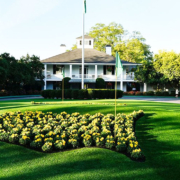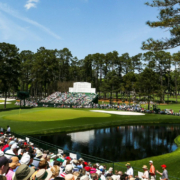You’ve Covered Half of The Masters?
It sounded funny to hear it out loud, even though the words had come out of my mouth.
“I’ve covered half of these you know,” I said with a chuckle to my colleague as we sat for a chat about my memories of The Masters Tournament.
“Now you’re going for the second half,” he laughed.
And it’s true, but still hard to believe. It was my forty fourth time at Augusta to cover the 88th Masters Tournament. The number would be forty-six except I was in Europe riding my bike one year and couldn’t get back in time and early on, my eldest daughter was born Masters week. (I’m not sure my wife appreciated her doctor and I bringing a small black and white TV into the room next to her “waiting room” so we could watch. Between contractions.)
When a letter with the return address “Augusta National Golf Club” arrived at my desk at Channel 2 in Charleston in January of 1979, I opened it not knowing it was the first step that helped define my career over nearly the next five decades. The letter was from Martha Wallace, the media coordinator for Augusta National, inviting me to apply for a credential to cover the upcoming Masters Tournament.
As a sports fan, I had followed the Masters, knew a lot of the history. I had watched on television as Gary Player made a downhill 10-footer for birdie on 18 the year before. And I remembered seeing Hubert Green miss a short putt on the same hole, also for birdie, to force a playoff.
Starting at Channel 2 in June of ’78, I had just missed the Masters and the Heritage golf tournament, a Charleston staple, that spring. I was familiar with the Heritage though, regularly attending pre-tournament events in Hilton Head promoting the Heritage.
But an invitation to The Masters was something totally different.
Over the years it’s funny to me that my memories of Augusta National and the tournament come in snippets, short stories, and videos of different parts of the experience, but all revolve around one thing: relationships. Relationships with staffers, players, patrons, and members all define my memories about my visits there.
Getting to know Coach and then his son behind the bar in the Grill Room was something I looked forward to every year. And over the past two decades or so, Vince in the same spot has become a daily staple each day I’m at the Masters.
Standing under the Oak Tree, away from the crowd, smoking a cigar and just observing became one of my own personal traditions. But sharing that time, and a cigar, with a visiting official from Argentina, made it even better. With my Spanish at an all-time low, and him just learning English, it was a half-hour of a non-verbal conversation about how good we had it I’ll always remember.
“How did covering The Masters impact your career away from the tournament,” my colleague asked. It was a good question, and something I hadn’t thought about. But quickly, I recognized that my experiences at Augusta had set the tone for how I worked the rest of the year.
Nobody’s ever in a hurry at Augusta, but everything about the tournament runs on time and is very efficient. I realized I’d adopted that philosophy in the other parts of my career. Be quick, be efficient, but don’t be in a hurry.
Being 6’3” and 240 lbs. was very helpful in an NFL locker room getting interviews post-game. I never needed that skill or tactic at Augusta. It’s organized and efficient and they’re doing everything they can to help you do the best job possible.
That’s different from so many other places where the media is held at arm’s length and is considered almost an adversary. At Augusta, you’ve always felt included as a part of the event. You can draw a direct line from Clifford Roberts’ cultivation of a relationship with Grantland Rice and OB Keeler to originally elevate the Masters profile in its early years to the continuing inclusive nature of the media’s role at Augusta.
That hasn’t exempted the club, nor the tournament from criticism throughout its history. But true to form, never in a hurry, they do the right thing.
I’ve always been amused with people saying The Masters and Augusta National are overly “romanticized.” Not true. They are that romantic when the definition of the word is an “idealized view.”
Former Chairman Billy Payne once told me it was important for the Masters and Augusta National to “be the best.” That’s what you find there, and not in an arrogant or dismissive way.
“I’d present three different solutions to the Chairman,” one former staffer recalled. “They’d vary in scope and cost and without exception, he would always choose option number one, the best. ‘Why wouldn’t we do it the best way we can?’ was always his attitude.”
That was an attitude I easily adopted. “Why wouldn’t we try and be the best we can be,” was a philosophy that occasionally put me at odds with my employers. I had a hard time accepting they were willing to do a job that was “fine” when I knew we could do better. Often at the same expense.
I’ve written here in the past of my first time walking into the Quonset hut serving as the media center for the Masters Tournament. As a young reporter, (I had just turned 24) I was quite star struck at the array of journalistic talent seated now right in front of me. Dan Jenkins, Bob Green, Furman Bisher, Hubert Mizell, all writers I’d read but never met, all icons in the business, were diligently working away at their manual Smith-Corona’s.
I’ve recalled the number of microphones coming toward me out of the gloaming as I asked Fuzzy Zoeller some inane question (I’m sure) shortly after his winning putt in the playoff on number eleven. I’d never been in that situation before at a major event. Recognizing the logos from Channel 9 in Australia, the BBC, the American networks, and others from around the world, I distinctly remember thinking, ‘Wow, this is a big deal.”
I’ve recounted “The Walk” I take every year when I first arrive at Augusta, heeding the words Jack Nicklaus told me early on. “Go walk the golf course,” he told a fresh faced me, the first time I spoke to him at The Masters. “When you get here, go see it for yourself. The changes, what it feels like while you’re out there. You’ll learn a lot.”
And I’ve described “The Walk” in the fall of 2020 when I arrived at Amen Corner only to be surprised to be the only person there. No players, no staff, concessionaires, members, or officials around. I was lucky enough to recognize how special, and unique that was, and took time to just take in the experience and be in the moment.
So, when my colleague asked, “After all that, what advice would you give to a young reporter coming to their first Masters this year?” I realized I hadn’t thought of that, but the answer came easily.
“Go for a walk, I’d tell them. See the golf course for yourself. Notice the changes and how different it looks in person from what you’ve experienced on television,” I said. “And open your mind to learn. Pay attention to how some of your experienced colleagues are doing their job. You’re not going to make a name for yourself by being some flash in the pan at Augusta. But you’ll legitimize yourself and your career by just being here.”



